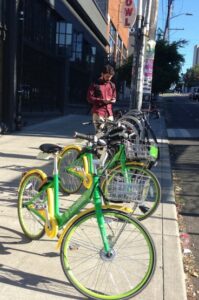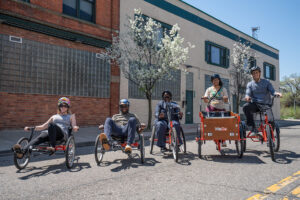Low-Income Communities
Just how great is the disparity in bikeshare usage between socioeconomic groups and races? Much of that depends on the market in question, but some of the biggest bikeshare systems in the country have faced significant criticism for not sufficiently serving populations that stand to benefit the most from the new mobility option. For example, in Chicago, only 2% of the city’s bikeshare systems’ memberships were held by black residents in 2017, despite the fact that African Americans comprise 30% of the city’s overall population (Greenfield, 2018). Chicago is not alone: Washington, D.C. is approximately 50% black, but in 2015, only 3% of Capital Bikeshare memberships were held by black residents (Schneider, 2017).
Station Placement: Some of this discrepancy has to do with bike and station placement. For example, a 2016 study of the seven biggest bikeshare systems in the country found that in most markets, people making over $100,000 annually were more likely to live within 0.3 miles of a bikeshare station than people making less than $20,000 – as were people with a college degree when compared to those without one (Jaffe, 2016). Researchers and bikeshare advocates assert that ridership among socioeconomically disadvantaged groups can increase with dense and convenient docking station placement.
Financial Barriers: However, even the discrepancy in geographic access to bikeshare does not completely explain the relative lack of use among minority and disadvantaged communities. Placing docking stations equitably certainly improves accessibility for these communities, but is not comprehensive in addressing all barriers. Possibly the most significant barrier for low-income earners is the costs associated with bikeshare. Fortunately, most large bikeshare operators are addressing this by offering reduced fares for eligible users, flexible payment plans for long-term passes, and cash payment options to accommodate users without credit cards. As an example, Chicago, IL offers a $5 annual pass to its Divvy bikeshare for low-income residents, as well as those receiving SNAP, WIC, or public house assistance. The enrollment costs are tiered annually, with the fourth year membership costing $79. Furthermore, Chicago’s “Divvy for Everyone” program also allows people to sign up in person and pay with cash at locations around the city. Initiatives like this can help address a major barrier for low-income bikeshare users.
Infrastructure: A major barrier to bikeshare accessibility for disadvantaged communities is with biking infrastructure, and specifically inequitable distribution of biking infrastructure. Lower-income, minority communities are regularly left behind when it comes to protected bike lanes, off-road paths, and traffic calming measures when compared to wealthier, whiter communities. Not only does this cause disproportionately more traffic injuries and deaths in these communities, but it also leads to overpolicing, as riders will often have to bike on sidewalks to avoid unsafe road conditions. In Chicago, IL, bicycle riders in majority-Black neighborhoods received tickets for riding on the sidewalk eight times more often per capita than riders in white neighborhoods. Organizations like Vision Zero are attempting to address these disparities.
Community Engagement: One of the greatest barriers to equitable bikeshare systems is community disengagement. Studies suggest that the lack of information on discount programs, safety, and concern regarding liabilities and hidden fees are among the greatest concerns for residents of low-income, minority neighborhoods, and that members of those communities simply had less exposure to bikeshare through their friends and families (Huth & Salem, 2018; McNeil et al, 2017a). A 2017 study addressing common misconceptions people might have about bikeshare found that while some misconceptions (for example, availability of reduced-price passes or ability to purchase passes without a smartphone) were pervasive in many communities regardless of race or income level, lower-income people of color were more likely to hold such misconceptions than any other demographic group, making bikeshare a less viable mobility option for those people (McNeil, 2017c). Unless targeted communities have reliable sources from which to find out about low-cost memberships, free helmet programs, bike laws, liability risks, or adaptive bike availability, then system usage will remain inequitable. Some bikeshare systems have addressed this through community-oriented programming that combats negative perceptions and misinformation about bikeshare. For example, Minneapolis, MN’s Nice Ride bikeshare launched the Nice Ride Neighborhood pilot program as an approach to promote bikeshare in neighborhoods with higher rates of poverty and low bikeshare ridership. The program organized and sponsored events and group rides led by local bicycling clubs, offered education on bicycling and traffic rules, and provided unique Nice Ride bicycles to some users in an effort to raise interest and promote a sense of community centered on bicycling. This type of community-focused programming is key to fostering equity in bikeshare systems.
For more information, visit SUMC’s Learning Module on Community Engagement
Next Subsection
Adaptive Bikeshare
In order to accommodate users with physical disabilities, adaptive bikeshare programs provide tricycles, recumbent bicycles, hand-powered bicycles, or other adaptive vehicles. Bikeshare systems can serve as a much-needed mobility mode to complement paratransit service. However, in many cities, adaptive vehicles that meet the needs of people with disabilities have yet to be included on a large scale. Because successful adaptive bikeshare must address a wide range of user needs, it becomes more difficult to reach a large network effect. Currently, most adaptive bikeshare systems operate as bike libraries in partnership with bicycle shops or non-profits near recreational facilities like off-street trail networks. Other programs use a similar formula, but are piloting efforts to include the reservation and marketing in wider bikeshare programs. Examples of this include Detroit, MI’s Adaptive MoGo bikeshare, San Francisco, CA’s Bay Wheels, and Portland, OR’s Adaptive BIKETOWN. These programs are limited in many ways and still require advance reservation, but as part of the wider bikeshare programs in these cities, they are branded and discoverable on the app and website, and are a step in the right direction for more equitable bikeshare.
Other adaptive programs allow for users to get the vehicles delivered to them. Fort Collins, CO recently launched an adaptive bikeshare program, Spin, where users can request an adaptive bicycle online or through the phone, and staff will bring the vehicle to the requested location.
Milwaukee, WI’s Bublr bikeshare is the first system in the United States to fully integrate adaptive vehicles into its fleet. In this program, tricycles, side-by-side vehicles, and handcycles can be checked into and out of any docking station in the city.
For more information on adaptive bikeshare or other ways shared mobility can help people with disabilities, please see SUMC’s Learning Module on Persons with Disabilities
Previous Subsection Next Subsection
Additional Reading
Many city agencies and community organizations are exploring ways to address these barriers in order to ensure that local bikeshare systems are as equitable as possible. Below are some of the ways different cities are working to address different obstacles. Another excellent resource from the National Association of City Transportation Officials and Better Bikeshare Partnership is the Strategies for Engaging Community report, released in 2018.
Below are some tools and examples of efforts to address bikeshare barriers:
Efforts to Address Barriers related to Geographic Coverage:
- San Francisco, CA: 20% of bike docks required to be in low-income communities | To improve coverage, the San Francisco Municipal Transportation Agency requires that at least 20% of the docking stations in its bikeshare system – Bay Wheels, operated by Lyft – be located in low-income communities (SFMTA). This course of action places the burden on the operator to ensure that any future expansions are not confined exclusively to wealthy areas that may already have mobility options.
Efforts to Address Barriers related to Safety and Comfort Concerns:
- Basalt, CO: Free Spanish-language bike classes | WE-cycle, the bikeshare system in Basalt, Colorado, runs “Movimiento en Bici”, a Spanish-language program intended to increase ridership among Latinix residents. The program helps residents sign up for the system, and overcome language barriers related to use; recently, it has also begun offering classes for adults who want to learn (or relearn) to ride.
- Oakland, CA: SPUR equity bike plan development process | In Oakland – as in much of the country – many residents resent bikeshare programs as harbingers of gentrification, or unnecessary in light of pot-holed and neglected streets. As a result, when developing its new bike plan to bring the majority of residents within ¼ mile of a safe bike route, Oakland DOT chose to first prioritize listening to those who faced the “greatest vulnerabilities and disparities in the transportation system” currently (City of Oakland, 2019). The agency teamed up with five local community groups to help facilitate engagement with the disadvantaged communities in East and West Oakland, and they held 60 community events to gain feedback and comments on their plan. This type of community engagement not only helps to ensure that underprivileged neighborhoods receive the type of mobility service that best suits their needs, but it also helps to increase community trust in and awareness of the bikeshare programs themselves. These 5 community groups are now well-positioned to serve as up-to-date sources of information on new programing opportunities and regulations for their residents.
Efforts to Address Barriers Related to Financial Concerns:
- Philadelphia, PA: Through a partnership with PayNearMe that enables consumers to make online purchases using cash at select retail chains, Indego bikeshare riders in Philadelphia can sign up for cash memberships online. They then receive a barcode that they can either print out or load onto their mobile phone, and a cashier at a participating 7-Eleven or Family Dollar scans the barcode and accepts the cash payment.
- New York City, NY: In conjunction with Vision Zero, NYCDOT has held events where they distribute helmets for free to attendees of all ages. For both those who (mistakenly) believe that a helmet is required to use bikeshare, and for those who cannot easily purchase one, free helmet distribution events can help address those concerns. They can also serve as opportunities to answer other bikeshare related questions, and to promote awareness of programs designed to support ridership among disadvantaged populations.
Efforts to Address Physical Disabilities
- Chicago, IL: Requires implementation of adaptive bikeshare in 2019 agreement with operator | In the City of Chicago’s 2019 agreement with Motivate to continue operating the local bikeshare system, Motivate was required to continue operating a summer youth jobs program, extend the “Divvy for Everyone” program, and continue to focus on hiring ex-offenders and veterans. Plus, Motivate is now required to “develop a pilot adaptive bike sharing or rental program, based on reasonable feedback from surveys and focus groups with representatives of the disability community and affected partners, within six (6) to twelve (12) months after the Effective Date. Such program may (i) be a stand-alone program staffed by personnel that will facilitate rental of adaptive bicycles (i.e., non-self-service), (ii) use the Divvy Marks, and (iii) operate in coordination with third parties, such as bike stores or the Chicago Park District.”
More equity-related resources can be found in the conclusion section of this Learning Module.
Previous Subsection










